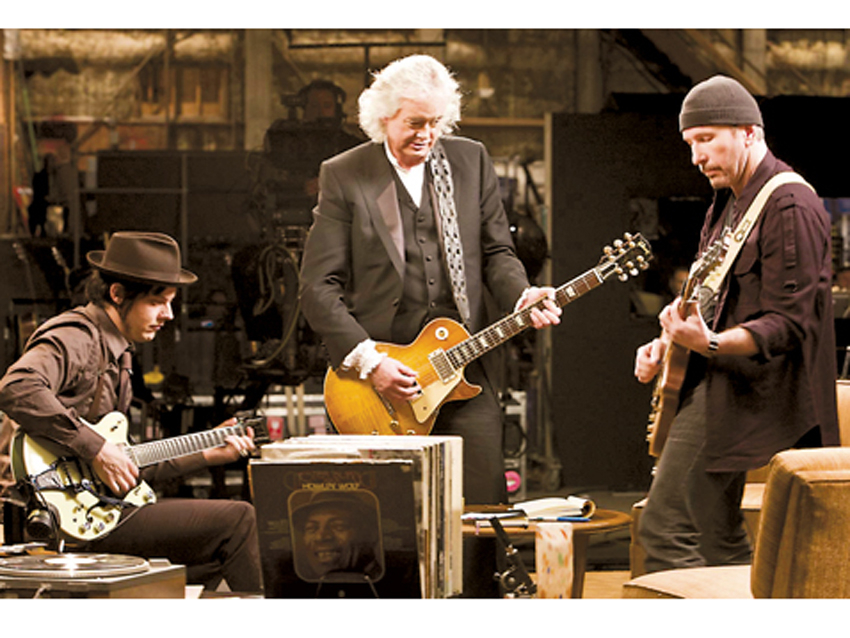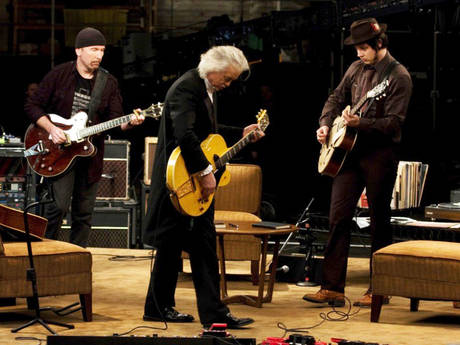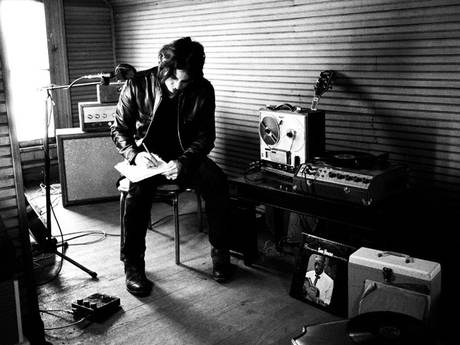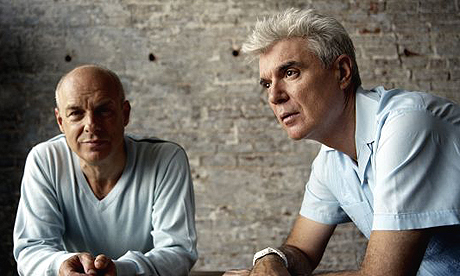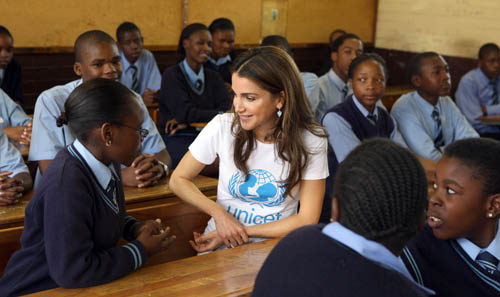Mojo MARCH 2009 - BRIAN ENO - by Mike Barnes
He was Roxy Music's synth-basher and the architect of ambient. Now outside-the-box boffin Brian Eno is working with U2 and Coldplay. "Producing is the best paid form of cowardice," he says.
it's a grey, rainy morning in November and Brian Eno is concerned that the roof of this west London mews house, which has been converted into an office/studio, is leaking. Two young women help him clear up, as his PR fields calls. Peter Chilvers, with whom he worked on Bloom, a new generative music and visuals application for the iPhone, comes in and sits at one of a number of huge computer screens. "I'll have to be out of here by noon," Eno warns. "I'm in the studio with U2 today." He proffers a cup of particularly delicious tea, Ahmad's Ceylon Cardamom blend. "My favourite. Do you know what that big box costs? £2.90. That's the bargain tea of all time," he says proudly.
Eno's career as a musician, visual artist and producer has been hallmarked by an ability to think differently to and ahead of prevailing trends - outside the box, if you will. From humble beginnings in the Suffolk town of Woodbridge, where he was born in 1948, Eno received a radical education at art schools in nearby Ipswich, where he was introduced to the conceptual constructs of American composer John Cage, and then Winchester, where he dabbled in performance art and championed the cause of the 'non-musician'. By way of demonstration he joined Roxy Music in 1971, playing synthesiser with an utterly shameless lack of technical ability in the hey-day of the progressive rock keyboard wizard.
He left the group in 1973 for a career that encompassed his love of rock'n'roll and pop, and a fascination with theoretical and systems music. Eno's need for a constantly fresh approach to his work prompted him to devise Oblique Strategies, a deck of cards, each bearing an instruction to suggest new approaches to creative endeavour. Mid-'70s hot-shot musicians like Robert Fripp or Phil Collins, when recording with Eno might, for example, be advised to: "Honour thy error as a hidden intention". In early 1978, with punk still holding sway, Eno came up with its antithesis, a blueprint for a new form of muzak - ambient, he labelled it - and released the deliberately diffident, low-key Music For Airports.
Some of Eno's most potent work has been as a collaborator, most notably with David Bowie on Low, "Heroes" and Lodger, and with Talking Heads, David Byrne and scores of other artists. Since the late-'70s, he has been constantly in demand as a producer, U2 being his most famous charges. Add lecturer, diarist and political activist to his CV for the profile of a twenty-first century renaissance man.
Despite his impending appointment with U2 and the hubbub around him as we talk, Eno appears calm throughout. Phone calls are waved away and he remains concentrated and focused, even as the interview stretches beyond its allotted hour.
You've been interested in musical systems ever since you modified your grandfather's player-pianos while at junior school. What with the double tape-recorder loops of Discreet Music and music-and-visuals software like Bloom, has your music making always related to a sense of play?
I think it does, to some extent, relate to my fascination to what I call economical systems. I've always been impressed by art that didn't use much to produce quite a lot. Mondrian, for instance, was the first painter that I really loved. I was very young when I first saw Mondrian's pictures - I wasn't even a teenager then - and I remember thinking, "How can something so simple be so powerful to me?" That was the great magic of art: something that was in every physical sense obvious - you could see exactly what it was, there were no tricks - but somehow it worked: it made me feel something. So I was always inclined in that direction rather than the opposite direction, which might be to throw in everything and the kitchen sink. Then it's not surprising that you are impressed by the result. I like it when there isn't much there. I guess that's why a lot of the music I like is like that: gospel music where you have the same three chords and maybe one minor chord; where there's nothing in the music in a musicological sense.
By the time you were nineteen, at Winchester School of Art, you were writing about and experimenting with ideas that came from the avant-garde. Has that way of thinking, which in those days was a bit outré for rock music, now infiltrated the mainstream?
I think what is more accepted is the idea that musicians might be articulate and interested in something other than sex and drugs, though of course we are all very interested in those. I can remember very strongly how powerful the resistance was to that in the '70s. It was like people were terribly disappointed if you could articulate a sentence because it meant you weren't really a proper passion-driven, lust-driven, rock'n'roller. because you have to remember that the archetype then was Keith Richards - a very powerful archetype.
And so it was considered, especially by music critics - who, of course, are much more rock'n'roll than any rock'n'roll artists ever are, in their minds at least - to be really bourgeois, a real letdown. You had to be working-class, which I am, actually: much more than most of them, as it happens. But it was like you (adopts slightly moronic voice) had to really fuckin' show it! And to admit that you had ideas was seen as hypocrisy. But now I think... well, I don't know really. I don't know anything about popular music really, but I think it's OK now to be brainy (laughs). At last!
You work a lot more in the mainstream now and I heard a rumour that you were going to produce Jason Donovan. Is that true?
(Dismissively) No! He lives there (points out of window to opposite mews house). This is an example of why you really have to read everything with total scepticism. My experience of reading the media in general is whenever there is something I know about, it's reported wrongly. Every single thing that I've actually been involved in has been wrongly reported. Let me tell you how that story started, just to show you how badly things can go wrong.
I was sitting here one day; Jason knocks on the door. I know him, he's a friend of mine and he says, "Hi Brian, I'm doing this record of rock'n'roll songs. Can you think of any songs I could do?" I've got loads of old rock'n'roll and doo wop songs and went through all my collection and found about twenty songs that I thought he'd like to consider. I lent him the records and he ended up recording about three or four. But then I happened to say to him, "You know, these kinds of songs are actually pretty easy to write." (Picks up an acoustic guitar) All you need is to tune your guitar to a major chord, and then you go (uses index finger to make barre chord and starts playing). He says, "Oh, that's really good." So I played it again and he started singing, and he said, "I could make a song out of that." I put it on a CD for him. That's the end of the story. (Eno carries on playing) Anyone can play a guitar like this.
Is this also how you make your songs, with these tunings?
Yes, it's a secret weapon of the guitar, the pre-prepared tunings. Keith Richards does it a lot, him having come up in conversation recently. Jimmy Page does it as well.
One of the first gigs I went to was Eno and The Winkies - your touring band - at St Andrew's hall, Norwich, in 1974. You sang Peggy Lee's Fever, and wore a sort of black cat suit, girls pawing at you. Before that you'd been a flamboyant pop star in Roxy Music. Was it good fun at the time?
Not really. I just got bored with it. I like reading and writing and talking, that kind of thing. And that kind of lifestyle doesn't permit much of that. I don't particularly like being the subject of adulation. I always look at an audience and think, "You can do this, you idiots. Don't be so pathetic (laughs). I don't like fans very much to be honest. Of course I like people enjoying my music and I quite like being admired for having some good ideas, but the anoraky type of fan is a rather frightening object of humanity, because you think, "Please get a life; don't have mine."
What were you like as a drummer in your teenage rock'n'roll band The Black Aces in Woodbridge back in 1964?
It rather amazes me to remember that I was the drummer, because I cannot make my feet do something different from what my hands are doing. Except I only used two drumsticks and I drummed on a wooden chair... anyway, that's all history, we don't want to talk about that.
I was curious because you site the studio sound-world of rock'n'roll and doo wops as major influences.
Well, of course, like nearly all big changes in art forms, there was a huge technological side to the story. We always think of music rising out of people's minds, but I think what more often happens is that some new technological opportunity comes up and people start to think differently. For example, the combination of the three-minute single and the radio station is in my opinion what gave birth to rock'n'roll. The content, of course, was drawn from a whole lot of Afro-American, Appalachian, Irish music that filled that new technological space, but what really drove the thing was that suddenly it was possible to make a three-minute piece of music stand alone, and it could be heard globally in a very short space of time through radio stations and this created a new way of thinking about music.
It also meant that you could make music that didn't necessarily have a performance aspect. Even with the early Spector records, the actual sound was irreproducible on stage and they didn't even try. They would have those girls doing And Then He kissed Me to a backing track. It's very modern, really.
You offer a theoretical basis for a lot of your music, but there seems to be a strong romantic and nostalgic thread dating back to your childhood. A prime example is Dunwich Beach, Autumn, 1960 from the ambient album On Land. Would you agree?
Yeah, I think that comes from coming from Suffolk, from a once glorious part of the country. Suffolk used to be the richest part of England a long time ago and you see melancholy remnants of that if you drive through a little village that has two houses and an enormous church. You see these big churches sitting in the middle of fields completely deserted by any community and that's so much part of the Suffolk landscape to me that I think there is a kind of melancholy to that, as though everything happened a long time ago, so you're living on the down-slope now. It's interesting to wonder whether the kind of music that I've been making could have had an entirely different kind of mood to it. I don't know, actually. I don't know if the theory and the mood are somehow bound up together and not separable, or whether it could have been otherwise.
It's interesting how music that was made with little emotional input, like your Music For Airports, can generate an effect that is moving emotionally. I read that you were misting up when you saw bang On A Can All-Stars play it live in 1998.
Yeah, that was the most interesting thing about that Bang On A Can experiment for me. You had a piece that was essentially made by machines - tape loops, that sort of thing. And s soon as humans try and reproduce it, they can't help but be human. When they are not trying to be passionately human but they are trying to restrain themselves, whatever comes through, it's the irrepressible part of being a human.
So they're all trying to act like machines, but they don't sound like machines at all, they sound like people and it's quite touching when that appears.
When you made some of your most innovative music - Roxy Music, Music For Airports, My Life In The Bush Of Ghosts with David Byrne - rock music was going through some major seismic shifts. Do you think it's as easy to innovate in 2008? Or is it necessary, even?
Those are both interesting questions. I'll talk to the second one first. A lot of what is going on at the moment is kind of recycling and I find that very, very interesting. It's as though the palette that musicians have available now is every style that has existed for the last fifty years or so. I mean, I even see it with my daughters. The content of their iPods is completely, insanely eclectic. They've got everything from doo wop to hip hop and everything in between. Which, when you think about it, it's as if I would have listened to music from 1906, when I first started listening to music. It's ridiculous! Even stuff from ten years earlier seemed hopelessly out of date.
And of course when you select a cultural block - like, to have it sound "kind of '80s" - you are recording more than just sounds. You are recording a story as well and a kind of image of what people are like and how they could be.
This is still completely original behaviour but it doesn't look original because it's recombining blocks that we think we recognise. But I think once they are recombined you hear them differently. I must say I have suddenly started to realise something I've never really understood before, which is the point of bands like Human League. I don't dislike them but they made no impression on me when they were around. But with them replayed and recycled, I can suddenly se their point. So I get them second time around.
Has this simultaneity of all eras of popular music in 2008 impacted on your own pop music like, for example, Everything That Happens Will Happen Today, your new album with David Byrne?
I think it probably has, because I don't feel that any style is old-fashioned. I think I can quite comfortably move - as in fact I do on that record - from something like West African music of the mid-'70s, to something like electronica. I don't feel awkward about doing that.I know all those kinds of music, I've been engaged with them, why shouldn't I use them? They are all part of my repertoire now. So I don't feel like that kind of thing is old-fashioned or you can't do that any more.
Returning to the first of those questions, do you feel any pressure on you to innovate?
Well, what happens when a new medium comes along like rock music, particularly studio-based recording - for a few years there are just so many things to do. Suddenly there is a whole new territory to open up, thousands of things to try, so it's very easy to innovate. You have to really fight not to innovate!
It happens in every medium for a short period at the beginning: all sorts of things that no one has seen or heard before, and then a quite lengthy digestive process, which is what we're in now, where people are looking back on all the stuff that's been done and looking at it differently and re-evaluating and saying, "This way of doing things, and this ... what happens if you combine them? What survives out of that combinations?"way
One of the things that the success of YouTube tells me that people are ready for something that isn't TV and that isn't film. They are ready for strange little things that just appear out of nowhere and catch on like wildfire. The problem for the industry os that they don't have any idea how to monetise that, but perhaps they don't have to. Maybe it will carry on without being monetised.
Do you still use your Oblique Strategies cards in the studio?
I do occasionally. In fact we use them for games sometimes. Like with Coldplay [on Viva La Vida], I started a sort of rule that we would improvise every day for a little while, just to sort of push the envelope so that we could explore different kinds of sonic worlds and different ways of playing. We could each take one card without telling anyone else what it was and that would be your rule for that improvisation. It produces really nice results sometimes, because it's very trying to guess what rule other people are working under.
Are there any times when it produced something utterly bizarre?
Very often (laughs). Which is what you want, of course, because partly what they exist for is to break you out of the habit patterns and push you into a different groove, making you do something you wouldn't have done otherwise.
You can design a piece of music and say, "OK, now we're going to do a song. It's going to have three sections, and in the middle section there's only going to be drums and voice, but the voice can only do one note. In the third section, everyone can play, but nobody must play on a beat that anyone else is playing."
Of course, the chances of you getting a great piece of music are quite remote. But the chances of you getting a seed for something are quite strong. You hear a voice singing a single note over a drumbeat and you think... "Ooh, it's not quite the right drumbeat or quite the right note, but there's something good about it."
Those ideas can get reincorporated later on. They become part of your vocabulary.
How do you assess the relative worth of all your different projects: for example, your work on the ten-thousand-year clock, The Clock Of The Long Now, and producing Coldplay?
I have never compared them. And I don't really think like that. I think of them as quite separate threads. And occasionally things do knot together. Like Bloom, which started out as quite an innocent, fun project, but it knots together a lot of things that I have been doing - more than I suspected. So it's usually in retrospect that I notice those connections; it's not at the time they are happening.
When you work with bands it seems that your role is more as a creative catalyst than a producer. Which of the artists you've worked with have taught you the most?
Probably U2. I was thinking about this, funnily enough, this morning when I was having a swim. One of the things that I find very, very interesting and sometimes infuriating about them is that they won't leave anything alone. So sometimes, they will come up with a song, a really good song, just like that. And they'll totally ruin it by trying to make it better. So the graph of them... (draws the axes of a graph on a piece of paper) Here's zero down here, the song's up there. You think, "Wow, fantastic, what an amazing piece." Then they will start smashing it to bits and it gets worse and worse and worse, and then it starts to get better and then it goes back up there. And you think, "OK, that's great. Now leave it alone!" Then the whole process goes down again. And so if you drew it as a graph... I'm going to draw this now, because I was actually wanting to do this graph to show them (draws a number of peaks and troughs)... Now, the reason this can be infuriating is if the record release deadline happens to fall there (points to peak), then that's wonderful. But (points to trough) if it happens to fall there (laughs)... and it is a little bit like that, it's like a roulette wheel spinning... Time is like a roulette wheel deciding when the thing comes out and it doesn't necessarily fall on a peak.
Do you have any final say in stopping them?
Well, I have to say that this process is one that we both do in the sense that sometimes they've said, "That's great, that's enough," and I say, "Well actually it isn't. It's quite like a lot of things you've done before. Let's push it a bit further." And ten I've started to drive it down the hill. So we sort of police each other. There's one song on this album that you could make a thirteen-part BBC series about because it's been through at least thirty of these processes where it has emerged as a totally different song, crashed again in flames and come out as something completely different again. I mean really different - nearly everything different.
What's your advisory role to the Liberal Democrats?
There are two parts to the question. First of all, why the Liberal Democrats? I like them because there ought to be an opposition party in this country and they are the only one. The Conservatives and Labour are all but indistinguishable because they are fighting for exactly the same demographic, and offering exactly the same solutions. The Liberal Democrats, in my opinion, completely distinguish themselves by standing out against the public mood and the mood of the media at the time by saying that they didn't believe that going to war in Iraq was a good idea. That was extremely courageous of them because there was such a clamour for it in the media, even the liberal media. So I liked them for that. And what I would like to do is to see if I can connect them up with new ways of starting a popular democratic movement in this country. I think that politics is so utterly out of the hands of people. It's just heavy artillery firing over their heads and they are stuck in the middle, and have so little connection to it.
I saw you talking about this on Question Time recently.
[Secretary of State for Justice] Jack Straw is still acting as though Iraq (imitates Straw), "Was a bit of a muddle, but a jolly good idea really." And he had the nerve to say that it might turn out to be a new democracy in the Middle East. I thought, "Yeah, it's going to be much easier now there are a million less people there." There's no sense yet of anybody in the British government saying, "You know what? We need to do a bit of a rethink on this." It's that typically British thing of losing the blame somewhere.
Have you ever refused to work with anyone?
I refuse a lot of requests. I don't especially want to spend a lot of my time working with other people. I love doing a little bit, but there's a kind of cowardice, because you earn a lot of money for it, but it's not your name on the record. If the record is a success, of course, the producer takes a huge amount of credit. And if it's a failure, the normal thing is for the producer to say... "They were so hard to work with." I feel that as a kind of reality check, at least, I have to do stuff myself and see where I stand in relation to it. You're asking everyone else to be brave, but how brave are you? (Eno orders car to get to U2 studio session)
It seems quite hectic in here this morning, and you seem very busy. How do you wind down?
You think this is hectic? There's an interesting article in New Scientist this week on what your mind is doing when you're not doing anything. It's a fantastic article. It's called "Vacant Mind, Busy Brain". The contention is that when your mind is apparently vacant, when you daydream, many parts of your brain close down but one part comes to life only then. It works furiously and consumes twice as much energy as any other part of the brain. It's now thought that that part is actually processing recent memories, and does it in the conscious mind's down-time, as it were, so all the computing power goes to the organisation. So you're asking me what I do to achieve that state (laughs).
One of the things I like about my installation work, the big pieces with light and so on, is that's what happens to me then. I always wondered why I like this state that I go into when I think, "Oh God, that's lovely"... uncritical self-admiration (laughs). I think it's down-time, I'm reprocessing then. And the reason other people like these shows is that it gives them the chance to do the same thing. What's interesting about those shows is what's missing: there's no narrative, no surprises, no pace. It's not like any other experience, really, except sitting and looking at a stained glass window, or something. There's no chance of projecting a story onto the whole thing. What that means is the part of the mind that normally would be doing that is allowed to daydream, to disengage. So maybe that's what I am doing there, providing opportunities for the mind to do that.
When you are working you go between two frames of mind: one is doing something, and the other is listening to something, you flip between the maker and the audience. I guess what I like is when I flip into audience mode and I'm comfortable being in that mode. So as soon as something makes me go into what I call "surrender mode", then I think it's going somewhere. There's a chance it will be worth doing something with.
I'm so sorry, but I must go now. I said that I'd be in the studio at twelve and I'm not going to be now.
BRIAN'S BRAIN
The many talents of Mr E
THE MUSICIAN Brian Eno: Another Green World (1975)
Another Green World marked the perfect melding of Eno's early, rather camp, art-pop songs, and the atmospheric abstract instrumental music that, as Ambient, would dominate his solo out put for years to come. It's also Eno's loveliest album, with his experimental approach marked by a charming naïveté. As to the guests, on St Elmo's Fire Robert Fripp plays a dazzling guitar solo, but most contributions - from John Cale to Phil Collins - add subtler details.
THE COLLABORATOR Brian Eno & David Byrne: My Life In The Bush Of Ghosts (1981)
In 1980, Eno professed to have a "psychedelic vision of Africa". This he brought to bear on Talking Heads Remain In Light's mix of Western pop, West African highlife and New York funk. This later venture with head Head Byrne developed those ideas. In an early example of sampling, all voices are taken from radio recordings or archives and include a hellfire preacher, an exorcist and recordings of Egyptian and Lebanese singers
THE PRODUCER U2: The Unforgettable Fire (1984)
This was Eno's first U2 production and a vitally important release for both parties. After 1983's big-selling War and Under A Blood Red Sky, the group could have travelled straight into breast-beating rock bluster. instead, they redefined themselves by making this deliberate left turn. Eno showed he could do big league production, here partnered by engineer Daniel Lanois. He emphasised the music's sleek momentum, giving a subtly impressionistic feel to The Edge's rippling guitar currents.
source: moredarkthanshark
